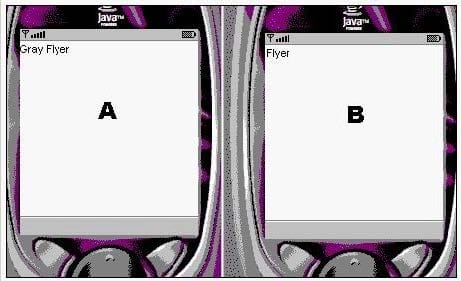1Z0-869 Online Practice Questions and Answers
Given:
1.
import javax.microedition.midlet.*;
2.
public class Foo extends MIDlet {
3.
public void go() {
4.
ThreadGroup x = Thread.currentThread().getThreadGroup();
5.
int numThreads = x.activeCount();
6.
Thread[] threads = null;
7.
x.enumerate(threads);
8.
}
9.
public void destroyApp(boolean b) { }
10.
public void pauseApp() { }
11.
public void startApp() { }
12.
}
What is the result?
A. Compilation fails because of an error on a line other than 4 or 7.
B. Compilation fails because of an error on line 7.
C. Compilation succeeds and the program runs without errors.
D. Compilation fails because of an error on line 4.
E. Compilation succeeds, but the program produces a runtime exception or error.
Which two properties of a Player can be set programmatically after its creation? (Choose two.)
A. time base
B. loop count
C. media content type
D. media source
E. size of data buffer
Which is true about CLDC support for accessing system property information?
A. Full support for java.util.Properties is available within CLDC.
B. CLDC supports a subset of java.util.Properties and also provides additional property information using System.getProperty().
C. CLDC supports a subset of java.util.Properties.
D. Property information is available in CLDC using System.getProperty().
Given a MIDP 2.0 device supports alpha blending, a MIDlet needs to render semi- transparent images of size 10x10 pixels. However, these images need to be generated at runtime. That is, they CANNOT be loaded as PNGs. What is the correct way to create a 10x10, red, semi-transparent image, using only the MIDP 2.0 API?
A. use createImage() to create a mutable Image; first fill it with white pixels, then fill it with red pixels
B. This is not possible. An Image with semi-transparency CANNOT be created at runtime.
C. use createImage() to create a mutable Image, then fill it with red pixels
D. use createRGBImage() to create an immutable Image from ARGB data with the desired values
Which is false about untrusted MIDlet suites?
A. Untrusted MIDlet suites may access protected APIs or functions if given explicit user permission.
B. JTWI devices must treat all MIDP 1.0 suites as untrusted.
C. JTWI devices must treat all MIDP 2.0 suites as trusted.
D. An untrusted MIDlet suite does not request permissions explicitly in the JAR manifest or the application descriptor.
A MIDlet that is to be installed on a phone has different values for the MIDlet-Name property between the JAD file and the manifest in the JAR file. Which is true?
A. A dialog is presented to resolve the conflict.
B. The value in the manifest overrides the value in the JAD file.
C. The value in the JAD file overrides the value in the manifest.
D. The MIDlet installation process will be aborted.
What is the minimum number of received SMS messages that a JTWI device must be able to concatenate?
A. no minimum
B. 5
C. 3
D. 10
E. 32
Given the MIDlet code:
3.
public void go() {
4.
try {
5.
doStuff();
6.
} catch(java.lang.IllegalAccessError e) {
7.
aForm.append("An Error");
8.
}
9.
}
Assuming the aForm variable on line 7 is a correctly initialized Form and set to the current display, what is the result?
A. Compilation fails due to a problem on line 7.
B. The MIDlet fails at runtime due to a problem on line 6.
C. The MIDlet fails at runtime due to a problem on line 7.
D. An Error is printed to the display if an IllegalAccessError occurs.
E. Compilation fails due to a problem on line 6.
Which three statements are true regarding the handling of wireless connections? (Choose three.)
A. Network connections should never be performed on a separate thread, so problems can be handled quickly.
B. Performing network operations on the same thread used by the display is likely to block refreshes of the display until the network operations complete.
C. The connection could unexpectedly terminate while processing the input or output streams.
D. Devices can only support one HttpConnection at a time; therefore, network access from multiple threads must be serialized.
E. A network connection could interfere with other services on the device, such as the ability to receive phone calls or SMS on a phone.
Click the Exhibit button. Which produces the results shown in device A and device B?

A. A: g.drawString("Gray Flyer",0,0,Graphics.TOP | Graphics.BASELINE);
B. g.drawString("Gray Flyer",0,0,Graphics.HCENTER | Graphics.BOTTOM);
C. A: g.drawString("Gray Flyer",0,0,Graphics.LEFT | Graphics.BASELINE);
D. g.drawString("Gray Flyer",0,0,Graphics.LEFT | Graphics.HCENTER);
E. A: g.drawString("Gray Flyer",0,0,Graphics.TOP | Graphics.LEFT);
F. g.drawString("Gray Flyer",0,0,Graphics.TOP | Graphics.HCENTER)
G. A: g.drawString("Gray Flyer",0,0,Graphics.LEFT | Graphics.TOP);
H. g.drawString("Gray Flyer",0,0,Graphics.TOP | Graphics.BASELINE);

